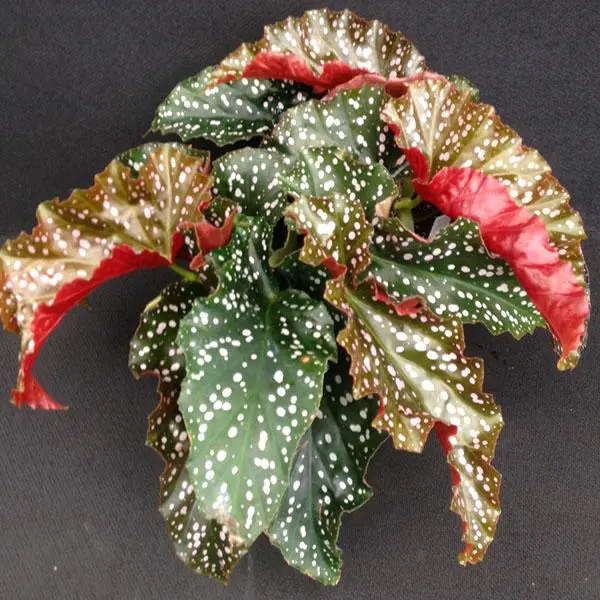B. ‘Cracklin’ Rosie’ was developed by Walter Dworkin several years ago, and today it is swiftly becoming one of the most popular and beautiful of recent cane hybrids. Why? The leaves, the leaves!
The leaves of B. ‘Cracklin’ Rosie’ are, in my opinion, among the most beautiful of all begonias. Fluted, wavy, with a rich dark bronze color that deepens in bright light, each leaf is heavily spotted with diminutive pink spots that compliment the dark red reverse of the leaf. The overall effect creates a leaf that is very red, dark, and haunting.
Flowering is not profuse, and in the two years that I have grown this hybrid, I have only had a few clusters of rosy-red flowers develop, but then I am not growing B. ‘Cracklin’ Rosie’ for the flowers, am I? Culture is surprisingly easy for such a dramatic cane, requiring only general cane care of bright light; rich, porous soil; and frequent fertilizing. Allowing the soil to dry out also helps.
While not a huge grower, it has reached a sizable 3 1/2 feet under my tropical, Tampa Bay conditions. Problems are few and far between, with the most noticeable being debris collecting within the flutes of the leaf. Periodic flushing of the leaves with water takes care of that. I also suspect that B. ‘Cracklin’ Rosie’ would make an excellent light garden subject as the color would be fantastic!
B. ‘Silvermist’ is the mother of B. ‘Cracklin’ Rosie’ and the other parent is B. ‘Salmon Rubra’. (Walter Dworkin says that this is the true parentage of his 1990 cross, a correction for the next updating of the Buxton Check List.) The vigor and beauty of this hybrid shines through. A winner no matter how you grow it, this is one mujer that will demand attention in our begonias collections for years to come.
Greg Sytch grows begonias at Sunshine State Tropicals.



